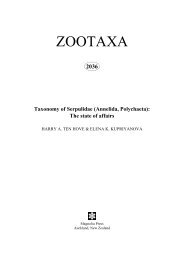Create successful ePaper yourself
Turn your PDF publications into a flip-book with our unique Google optimized e-Paper software.
Taxonomic notes:—Desmoncus giganteus is characterized by its large size and unusually large fruits<br />
with long fruiting corollas. It is the only species of Desmoncus always reported to have solitary stems; all<br />
other species have clustered or rarely solitary stems. It is probably more common than the few specimens<br />
suggest.<br />
Moreno Suárez and Moreno Suárez (2006) consider that this species occurs in Bolivia. However, the<br />
description and illustrations they give of the fruits do not match those of D. giganteus, and appear more like<br />
those of the large morphotype of D. polyacanthos.<br />
5. Desmoncus horridus Splitg. ex Martius (1844: 51).<br />
Atitara horrida (Splitg. ex Martius) Kuntze (1891: 727). Type:—SURINAME. Paramaribo, no date, F. Splitgerber 61<br />
(holotype BR, n.v., holotype image!).<br />
Plants 6.7(2.0–15.0) m tall; stems 2.4(1.2–4.8) cm diameter, clustered. Leaf petioles 4.6(2.0–11.5) cm long;<br />
rachises 123.8(32.0–220.0) cm long, 9.5(3.4–20.5) mm wide, the spines usually >1 cm long, mostly adaxial or<br />
lateral, straight with briefly swollen bases; pinnae 19(7–28) per side of rachis, without a beard of spines at the<br />
bases, without spinules or dense tomentum at the bases adaxially; basal pinna 21.6(12.0–34.0) cm long,<br />
1.9(1.3–3.7) cm wide; cirri well-developed, with acanthophylls, without spines abaxially, with intermediate<br />
acanthophylls present, without a wide gap between pinnae and acanthophylls. Inflorescences with the rachis<br />
ridged, not twisted, much thicker than the numerous, closely spaced and spirally or irregularly arranged<br />
rachillae, each rachilla not or only briefly adnate to the rachis, subtended by an acute bracteole and with a<br />
well-developed axillary pulvinus; peduncles 6.4(2.3–13.1) mm wide; peduncular bracts 28.3(10.5–47.0) cm<br />
long, broad, the surfaces ribbed, brown tomentose, sparsely to densely covered with long, straight or sinuous,<br />
briefly swollen-based, diagonally or vertically oriented spines, these flattened or triangular in cross-section,<br />
whitish-brown proximally, black or brown distally, with tomentose margins (rarely without spines); rachillae<br />
19(7–33), brown tomentose initially; proximal rachillae 10.8(5.0–17.5) cm long, 1.3(0.7–1.9) mm wide;<br />
stamens 6–7; fruits 15.4(10.6–21.1) mm long, 9.5(7.4–12.4) mm wide, the surfaces uneven with numerous,<br />
subepidermal, short, often branching (Y-shaped) fibers; fruiting corollas less than one quarter as long as fruits,<br />
not or scarcely splitting, tending to remain cupular; endocarps narrowly ellipsoid with rounded apices, the<br />
pores lateral.<br />
Taxonomic notes:—Specimens included in this species were placed by both Wessels Boer (1965) and<br />
Henderson (1995) within a widespread Desmoncus orthacanthos Martius. This is a mistake, and the two<br />
species are quite distinct, especially in their fruits. The specimen from W illustrated in Dahlgren (1959, plate<br />
186) is not the type of D. horridus, and is anyway now destroyed.<br />
Subspecific variation:—There is geographic disjunction and specimens occur in five regions—a coastal<br />
region stretching from Tobago and Trinidad southeast through the Guianas to Brazil (Maranhão, Pará,<br />
Tocantins); an Orinoco region comprising the Orinoco river and its tributaries north and west of the Guayana<br />
Highland in Venezuela and reaching adjacent Colombia; an upper Rio Negro region, along the river and its<br />
main tributaries in Brazil and adjacent Venezuela and Colombia; a Pantanal region in Brazil and adjacent<br />
Bolivia; and a western Amazon region in Ecuador and Brazil (Acre). For most variables there are too few data<br />
to test for differences amongst these different regions. However, ANOVA shows that for pair wise comparison<br />
probabilities, seven variables (rachis length, basal pinna width, peduncular bract length, peduncle width,<br />
rachilla length, number of rachillae, fruit length) differ significantly (P
















